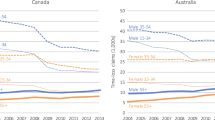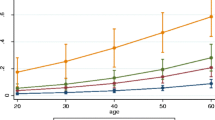Abstract
Introduction: The purpose of this study was to investigate if work-related musculoskeletal disorders (WMSDs) are associated with increased health care use, over and above workers’ compensation health care benefits, in the period prior to and following a workers’ compensation claim indicating gradual progression and declining function associated with musculoskeletal morbidity. Methods: This study employed secondary analysis of employment data, workers’ compensation claim data and provincial (universal) medical services data for a cohort of health care workers; and investigated rates of medical care contacts among injured workers with a WMSD claim (n=549) compared to a matched group of non-claim workers. Predictors of health care contacts were estimated using general linear regression. Results: WMSD injured workers had significantly higher rates of health care contacts associated with a claim compared to non-injured workers, over and above workers compensation health care benefits. In the final multi-variable model, a WMSD claim among injured workers was associated with an estimated 69% (95% CI, 1.50, 1.91) increase in health care use for the 12-month period immediately after the injury date compared to non injured workers. Conclusion: The pattern of visits for WMSDs suggests that workers visit general practitioners as part of an ongoing pattern of symptoms, resulting in frequent utilization of health services prior to work disability that is also reflected in health care contacts after return-to-work.



Similar content being viewed by others
References
Makela M, Heliovaara M, Sievers K, Knekt P, Maatela J, Aromaa A. Musculoskeletal disorders as determinants of disability in Finns aged 30 years or more. J Clin Epidemiol 1993;46(6):549–59.
Coyte PC, Asche CV, Croxford R, Chan B. The economic cost of musculoskeletal disorders in Canada. Arthritis Care Res 1998;11(5):315–25.
Fulton-Kehoe D, Franklin G, Weaver M, Cheadle MA. Years of productivity lost among injured workers in Washington state: modeling disability burden in workers’ compensation. Am J Ind Med 2000;37(6):656–62.
Workers’ Compensation Board of British Columbia. Statistics 2002. Richmond, British Columbia: WCB of BC, 2002.
Silverstein BA, Stetson DS, Keyserling WM, Fine LJ. Work-related musculoskeletal disorders: comparison of data sources for surveillance. Am J Ind Med 1997;31(5):600–8.
Liss GM, Kusiak RA, Gailitis MM. Hospital records: an underutilized source of information regarding occupational diseases and exposures. Am J Ind Med 1997;31(1):100–6.
Liss GM, Armstrong C, Kusiak RA, Gailitis MM. Use of provincial health insurance plan billing data to estimate carpal tunnel syndrome morbidity and surgery rates. Am J Ind Med 1992;22(3):395–409.
Park RM, Nelson NA, Silverstein MA, Mirer FE. Use of medical insurance claims for surveillance of occupational disease. An analysis of cumulative trauma in the auto industry. J Occup Med 1992;34(7):731–7.
McGorry RW, Webster BS, Snook SH, Hsiang SM. The relation between pain intensity, disability, and the episodic nature of chronic and recurrent low back pain. Spine 2000;25(7):834–41.
Hagberg M, Christiani D, Courtney TK, Halperin W, Leamon TB, Smith TJ. Conceptual and definitional issues in occupational injury and epidemiology. Am J Ind Med 1997;32:106–15.
Biering-Sorensen F. A prospective study of low back pain in a general population III. Medical service-work consequence. Scand J Rehab Med 1982;15:89–96.
Badley EM, Webster GK, Rasooly I. The impact of musculoskeletal disorders in the population: are they just aches and pains? Findings from the 1990 Ontario Health Survey. J Rheumatol 1995;22(4):733–739.
Rekola KE, Levoska S, Takala J, Keinanen-Kiukaanniemi S. Patients with neck and shoulder complaints and multisite musculoskeletal symptoms—a prospective study. J Rheumatol 1997;24(12):2424–8.
Williams DA, Feuerstein M, Durbin D, Pezzullo J. Health care and indemnity costs across the natural history of disability in occupational low back pain. Spine 1998;23(21):2329–36.
Molano SM, Burdorf A, Elders LA. Factors associated with medical care-seeking due to low-back pain in scaffolders. Am J Ind Med 2001;40(3):275–81.
Workers’ Compensation Board of British Columbia. Health Care Industry: Focus Report on Occupational Injury and Disease. Richmond, British Columbia: WCB of BC, 2000.
Adam MH. Declines in claims frequency continues to offset market losses. ON Workers’ Compens 2001;11(2):1–4.
Canadian Institute of Actuaries. Canadian Group Long-term Disability Termination Experience 1988–1994. Committee on Expected Experience Group Life and Health. Ottawa, ON: Author.
British Columbia Ministry of Health and Centre for Health Services and Policy Research.. Access Policy for Research Uses of Linked Health Data. Vancouver, BC: Author, 1998.
Chamberlayne R, Green B, Barer ML, Hertzman C, Lawrence WJ, Sheps SB. Creating a population-based linked health database: a new resource for health services research. Can J Public Health 1998;89(4):270–3.
Beaton DE, Cole DC, Manno M, Bombardier C, Hogg-Johnson S, Shannon HS. Describing the burden of upper-extremity musculoskeletal disorders in newspaper workers: what difference do case definitions make? J Occup Rehabil 2000;10:39–52.
Coyte PC, Asche CV, Croxford R, Chan B. The economic cost of musculoskeletal disorders in Canada. Arthritis Care Res 1998;11(5):315–25.
International Classification of Diseases (9th Revision). Practice Management Information Corporation: Los Angeles, California, 2003.
Hertzman C, McGrail K, Hirtle B. Overall pattern of health care and social welfare use by injured workers in the British Columbia cohort. Int J Law Psychiatry 1999;22(5–6):581–601.
Statistics for the Applied Sciences. SAS Procedures Manual. Cary, NC: SAS Institute Inc. 2002.
Allison PD. Survival analysis using the SAS system: a practical guide. Cary, NC: SAS Institute Inc., 1999.
Mustard CA, Goel V, Barer ML, Muhajarine N, Derksen S. Validity of self-reported utilization of insured health care services. Institute for Work & Health Working Paper #108. Toronto, ON: Institute for Work & Health, 2000.
Tacci JA, Webster BS, Hashemi L, Christiani DC. Healthcare utilization and referral patterns in the initial management of new-onset, uncomplicated, low back workers’ compensation disability claims. J Occup Environ Med 1998;40(11):958–63.
Dembe AE, Savageau JA, Amick III BC, Banks SM. Office-based medical care for work-related conditions: Findings from the National Ambulatory Medical Care Survey, 1997–1998. J Occup Environ Med 2002;44:1106–17.
Liss GM, Tarlo SM, Macfarlane Y, Yeung KS. Hospitalization among workers compensated for occupational asthma. Am J Respir Crit Care Med 2000;162(1):112–8.
Lavis JN, Malter A, Anderson GM, Taylor VM, Deyo RA, Bombardier C, Axcell T, Kreuter W. Trends in hospital use for mechanical neck and back problems in Ontario and the United States: discretionary care in different health care systems. CMAJ 1998;158(1):29–36.
Shannon HS, Lowe GS. How many injured workers do not file claims for workers’ compensation benefits? Am J Ind Med 2002;42:467–73.
Morse T, Dillon C, Warren N, Levenstein C, Warren A. The economic and social consequences of work related musculoskeletal disorders: The Connecticut upper-extremity surveillance project (CUSP). Int J Occup Environ Health 1998;98:209–16.
Carey TS, Evans A, Hadler N, Kalsbeek W, McLaughlin C, Fryer J. Care-seeking among individuals with chronic low back pain. Spine 1995;20:312–7.
Szpalski M, Nordin M, Skovron ML, Melot C, Cukier D. Health care utilization for low back pain in Belgium: Influence of sociocultural factors and health beliefs. Spine 1995;20(4):431–42.
Von Korff M, Saunders K. The course of back pain in primary care. Spine 1996;21(24):2833-2837.
Bergquist-Ullman M, Larsson U. Acute low back pain in industry: A controlled prospective study with special reference to therapy and confounding factors. Acta Orthop Scand 1977;170:1–117.
Wong O. Use of administrative databases in occupational and environmental epidemiologic research (editorial). Ann Epidemiol 2001;11(5):281–5.
Ekberg K, Karlsson M, Axelson O, Malm P. Cross-sectional study of risk factors for symptoms in the neck and shoulder area. Ergonomics 1995;38(5):971–80.
Skov T, Borg V, Orhede E. Psychosocial and physical risk factors for musculoskeletal disorders of the neck, shoulders, and lower back in salespeople. Occup Environ Med 1996;53(5):351–6.
Marmot M, Shipley M, Brunner E, Hemingway H. Relative contribution of early life and adult socioeconomic factors to adult morbidity in the Whitehall II study. J Epidemiol Commun Health 2001;55(5):301–7.
Acknowledgements
This research was supported by the Workers’ Compensation Board of British Columbia through the Finding Solutions Program. The principal investigator was supported by the Institute for Work & Health (Toronto) through the Mustard Post-doctoral Fellowship in Work Environment and Health and currently by the Michael Smith Foundation for Health Research Scholar Award. The Institute for Work & Health, an independent not-for-profit research organization, receives support from the Ontario Workplace Safety and Insurance Board. The authors thank the employees and administration of St. Paul’s Hospital (Vancouver) for their participation in the study and their assistance with data extraction. The authors are also very appreciative of the expertise provided by Kim McGrail at the Centre for Health Services and Policy Research (University of British Columbia) on the BC Linked Health Database. The authors thank Bo Green for his advice on the analysis of the health care utilization data.
Author information
Authors and Affiliations
Corresponding author
Rights and permissions
About this article
Cite this article
Koehoorn, M., Cole, D.C., Hertzman, C. et al. Health care use associated with work-related musculoskeletal disorders among hospital workers. J Occup Rehabil 16, 402–415 (2006). https://doi.org/10.1007/s10926-006-9022-7
Published:
Issue Date:
DOI: https://doi.org/10.1007/s10926-006-9022-7




